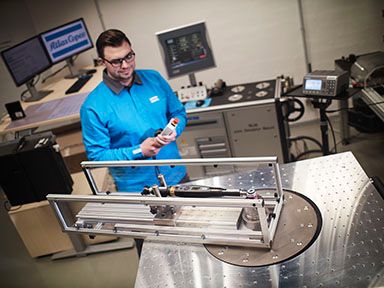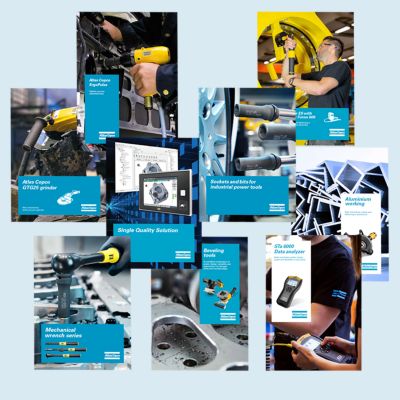December 17, 2023
Experience the transformation in transportation technology! It's all about using digital tools, powertrain electrification, and autonomous driving. As more electronic parts are needed for these advances, it's super important to keep them safe and working well. The reliability of electronic components depends on the precise application of essential sealants, adhesives, potting compounds, and thermal management. These elements are crucial for safeguarding electronic systems.

“It is important to protect sensitive e-mobility components, assistance systems, sensors, and assemblies against environmental influences. These are for instance high temperatures, dirt, moisture, and strong vibrations. The right dispensing and potting technologies prevent costly defects and failures. This may mean the difference between life and death.”
Marc Heiter E-mobility expert of Scheugenpflug Electronics Dispensing, Part of Atlas Copco Group
Importance of sensors in cars especially electric vehicles
Electric vehicles include many sensors, such as radar, parking distance, TMAP (Test Management Approach), ultrasonic, and image sensors. Safeguarding these electronic systems is extremely important to ensure electric vehicles' correct and safe operation. Sensors are protected through bonding, sealing, or potting with the help of varying viscosities. Housing contacts are shielded from harmful effects using appropriate bonding or potting materials. Given the diverse requirements based on sensor type, position, geometry, and function, no universal material is suitable for all applications.
Three topics to look out for protecting sensitive sensors and electronic equipment
- 1. Staying cool
- 2. Staying hidden
- 3. Staying failure free
Staying cool:
To avoid defects and failures in electronic equipment the heat they generate must be reliably dissipated. Dispensing accuracy, speed of application, and the wear and tear of the dispensing systems play a key role here. This applies in particular to dispensing for inductive charging stations, HV batteries, control units, onboard chargers, and Advanced Driver Assistance Systems (ADAS). Thermal management is also essential for power electronics as these components generate heat. Dissipating high temperatures supports the components to operate safely.
Staying hidden:
Manufacturers need to pott electronic components to ensure their long-term functionality. This also protects valuable know-how from prying eyes. The filling process varies depending on the geometry of the component and the properties of the potting material. In the production process, you can carry out this under atmospheric pressure or in a vacuum.
Correct material preparation is crucial if you want to achieve high-quality, reproducible potting results. Systems with robust feed pumps and sophisticated process technology ensure the necessary reliability of the process. For potting applications in particular, it is important to have precise measurements for the amount of material and for each component to be potted. This applies, for example, to the production of components such as LED headlights, sensors, and chargers. The filling is also a process in battery production. Battery modules and battery storage units, for example, are potted with liquid media. This makes the housing stable and prevents or slows down chain reactions in a worst-case scenario.
Staying failure-free:
Sensitive electronics are often exposed to environmental influences such as dust, moisture, and corrosive media. You as a manufacturer need to protect electronics against these influences. Applying highly viscous sealants to a component such as housing in the form of a bead, acts as a barrier. The sealants are usually applied automatically along a specific, predetermined contour.
It is important to apply the sealant along the intended contour precisely, repeatably, and continuously. Sensitive elements in particular, such as sensors, displays, inductive charging stations, and power electronics, require special attention. Especially, as the seal often also has to fulfill an adhesive function.
How to control air tightness of electronic equipment
Housings for electronic components have to be airtight. Absolutely airtight!
This is the last and most important step before the electronics are installed in the vehicle. Vision systems support perfect control of the airtightness of the components. They are inspecting these critical sealing applications. Our vision systems ensure that the quality of the sealing contour is exceptional, verifiable, and traceable.
E-mobility meets sustainability
Certainly, the global production of electric vehicles is set to surge, reaching approximately 35.7 million units by 2030 necessitating a proportional increase in sensors. The focus will shift to innovation, weight reduction, efficient supply chains, and minimizing the carbon footprint. Stakeholders are increasingly seeking transparent evidence of environmental impact.
Enhanced dispensing precision reduces material requirements, while advanced feed technology diminishes residue. Improved protection extends the lifespan of electronics, contributing to sustainability, safety, and reliability.
Discover how our Innovation Center help you solve your joining challenges
Our global Innovation Centers are the ideal place for testing and developing the optimal process for your needs. Our joining solutions experts support you to find the right process, system layout as well as accessories.
You might be interested





